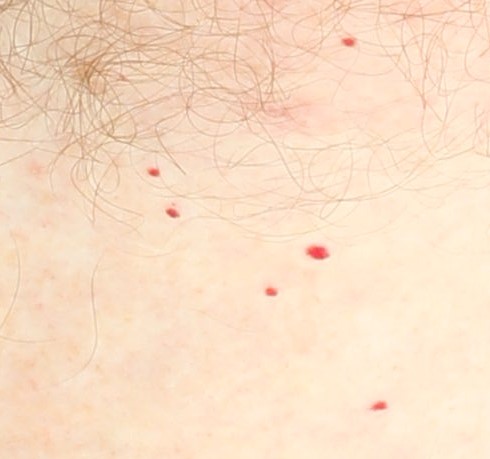 A higher number of cherry angiomas are seen in patients with a personal history of melanoma but not keratinocyte cancers.
A higher number of cherry angiomas are seen in patients with a personal history of melanoma but not keratinocyte cancers.
A Queensland study used three-dimensional (3D) total body imaging and machine learning to extensively map the anatomic distribution and characteristics of cherry angiomas in the general population.
The study of 163 adults in Brisbane found 66% of the cohort had ≥10 cherry angiomas >1mm in size; 24% had ≥10 lesions >2mm in size.
The most common sites for cherry angiomas were the front torso and back, while the least common sites were the head and neck.
“Being male, increasing in age, having fair innate skin colour, being of Caucasian ancestry other than British/Irish, and having green/hazel eye colour as opposed to blue as well as a personal history of melanoma were all associated with an increase in the number of cherry angiomas,” the study said.
“Specifically, every 1-year increase in age is expected to result in a 4% increase in the number of cherry angiomas; for an increase in 10 years this corresponds to an increase by 48%.”
The study, published in Dermatology, said people with a personal history of melanoma had 3.15 times as many cherry angiomas as those who did not have a personal history of melanoma.
However no relationship was observed between the number of cherry angiomas and >20 self-reported sunburns before the age of 20, skin reaction to first annual exposure to acute sun, freckling, number of naevi, past keratinocyte cancer, or self-reported family history of melanoma.
The authors, including Professor Peter Soyer from the University of Queensland, said the association between cherry angiomas and melanoma had also been observed in two Italian studies.
“Both studies were retrospective, and thus it is unknown whether the angiomas predated the melanoma or vice versa,” they said.
“Of note, a recent prospective study in Spain showed that having >50 cherry angiomas was predictive of developing a second melanoma.”
“While a few studies suggest that an association between cutaneous malignancies and multiple cherry angiomas is more than incidental, further studies are needed to test whether these associations are causal and prognostic, and whether development of cherry angiomas co-occurs with development of melanoma or is merely an epiphenomenon,” they concluded.